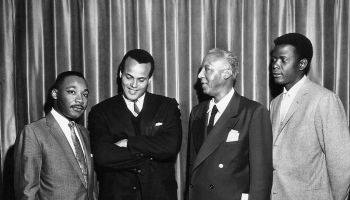Lance Armstrong is once again facing doping allegations by the United States Anti-Doping Agency.
This comes a few months after federal investigators closed a two-year investigation without any criminal charges.
STORY: Holy Jeez! Flesh Eating Bacteria Kills Pastor
These alleged criminal acts are nothing new for the seven-time Tour de France champion, who’s been accused of taking performance enhancers for years now.
Armstrong says in response,
“I have never doped, and, unlike many of my accusers, I have competed as an endurance athlete for 25 years with no spike in performance, passed more than 500 drug tests and never failed one,”
Armstrong further says in a statement, according to the Chicago Tribune, that,
“Any fair consideration of these allegations has and will continue to vindicate me.”
The move by the USADA immediately bans Armstrong from triathlon racing, which he turned to after his retirement from cycling.
The USADA should be a recognizable name to sports fans that have seen some of the greatest in our coveted sports, accused of or proven to have taken performance enhancers.
The non-profit agency was created in 1999; by the United States Olympic Committee. They are charged with managing the anti-doping program of U.S. Olympic, Paralympic, Pan-American, and Para Pan American sports, mainly centering around Olympic sports.
In 2001, the USADA was recognized by Congress to be, “the official anti-doping agency,” for the previously mentioned sports.
Unlike the norm for chief American sports organizations (MLB, NFL, NBA, NHL), the USADA works independently from the Olympic sports.
The USOC states that this is a benefit for two reasons. 1. They have an independent organization solely focusing on anti-doping matters. 2. Their independence also removes any perceived conflict of interest regarding their duties.
The agency has three goals enlisted in their mission. They are to “Preserve the integrity of competition, inspire true competition, and protect the rights of U.S. athletes.”
Furthermore, the agency is a signatory of, and responsible for implementation of, the World Anti-Doping Code, in the United States.
The Code, works in accordance with five international standards for uniformed and harmonized testing programs across the globe and is widely considered the basis for the strongest and strictest anti-doping programs in sports.
The five standards the agency works in conjunction with are the World Anti-Doping Agency (WADA), The International Standard of Testing (IST), The International Standard for Laboratories (ISL), The International Standard for Therapeutic Use Exemptions (TUEs), International Standard for Protection of Privacy and Personal Information.
The testing program takes place both in-competition and out-of-competition consisting of blood and urine samples, which can occur at any time, location, and without notice.
Although, in many cases these tests are targeted to specific athletes, events, locations, and times, not necessarily “random.”
Factors determining these tests are:
- Physical demands of the sport and possible performance-enhancing effect that doping may elicit
- Available doping analysis statistics
- Available research on doping trends
- The history of doping in the sport and/or discipline
- Training periods and the competition calendar, season
- Information received on possible doping practices
- Resources aimed at the detection of doping may be specifically targeted.
Managing results is a huge aspect of what the agency does. These positive results, aka committing an anti-doping rule violation (ADRV) include several things.
This spans from refusing a test, failing a test, tampering with a test, trafficking of prohibited substances, the attempt to do any of the following, etc.
Finally, what are the substances banned by the USADA for Olympic sports.
For a full list of substances and more information on them check out usantidoping.org.
To finish off we’ll give you five of some of America’s biggest athletes that have been, or are currently still being, investigated for doping.
[pagebreak]
Roger Clemens:
Currently on trial fighting testimonies of former trainer Brian McNamee who claims Clemens is guilty of using performance enhancers.
Clemens may manage to get off with no criminal charges, but his name is linked to performance enhancers. This leaves Roger at the mercy of the MLB Hall of Fame voters, who haven’t been kind towards the likes of Mark McGwire and other HOF caliber players linked to performance enhancers.
[pagebreak]
Alex Rodriguez:
Rodriguez, unlike Clemens, has come clean about using performance enhancers. However, there is heavy speculation in regards to the extent of his usage and what was used.
On Tuesday night, A-Rod joined Yankee legend Lou Gehrig tying him for first on the all time grand slams list, with 23. Several sportscasters have already discussed that record’s legitimacy as well as his other prestigious statistics.
[pagebreak]
Floyd Landis:
Fellow American cyclist Landis was stripped of his Tour de France title when a drug test showed he had taken performance enhancers soon after his victory.
Since then Landis has accused Armstrong and has been very public about it. The accusations, likely out of jealosy and frustration, have been detrimental to Armstrong who still has yet to test positive for a drug test.
[pagebreak]
Ryan Braun:
Milwaukee Brewers outfilder and reigning National League MVP has held his title with plenty of controversy. First off, many fans believed that the Dodger’s Matt Kemp was the rightful winner of the award.
Secondly, there was a urine test indicating that Braun had used performance enhancers. Braun had somehow been able to prove that his urine was tampered with making the sample test positive. However this ruling is also highly controversial.
So Braun got off the hook, kept his MVP title, and his case leaves many of us in confusion.
[pagebreak]
Brian Cushing:
Houston Texans star linebacker was suspended for the first four games of the 2010-2011 season for the use of performance enhancers.
Cushing took a similar route that Braun did, claiming the result was based off of a botched test. His attempt didn’t serve as useful to Braun who was able to get off on charges he faced.
















